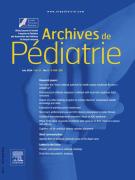Impact of prenatal estimation of the risk of respiratory distress in neonates with congenital pulmonary malformations on the choice of delivery site - 28/04/23

for the
MALFPULM Study Group1
Abstract |
Background |
The vast majority of prenatally diagnosed congenital pulmonary malformations (CPM) remain asymptomatic at birth. The maximal value of the CPM volume ratio (CVRmax) predicts the risk of neonatal respiratory distress (NRD), and should allow for better assessment of the level of expertise needed at the delivery site.
Aim |
This study evaluated the level of maternity units currently chosen for the delivery of CPMs, and determined the impact of the choice of delivery site based on the CVRmax, with a threshold of 0.4 cm2.
Methods |
Data were extracted from the French prospective MALFPULM cohort, with inclusion between March 2015 and June 2018.
Results |
The final study population consisted of 383 women. Deliveries in level 1 or 2 maternity units (n = 98, 25%) involved CPMs with lower CVRmax (p<0.001), causing fewer signs of prenatal compression (p = 0.025). Among the 62 children (16%) who presented with NRD, only seven (11%) were born in level 1 or 2 units (p = 0.0078). Choosing the maternity level according to the CVRmax would have increased the number of births in level 1 or 2 maternity hospitals by 70%. In these maternity units, the percentage of children with NRD would have increased from 8% in the actual distribution to 10% in the new strategy.
Conclusion |
Our results showed an overuse of level 3 maternity hospitals for the delivery of newborns with a prenatal diagnosis of CPM. The use of CVRmax should enable a reduction in the use of expertise centers without an adverse impact on newborns.
Le texte complet de cet article est disponible en PDF.Keywords : Birth, Congenital cystic adenomatoid malformation (CCAM), Congenital pulmonary malformation volume ratio (CVR), MALFPULM, Pregnancy
Plan
Vol 30 - N° 4
P. 195-200 - mai 2023 Retour au numéroBienvenue sur EM-consulte, la référence des professionnels de santé.
L’accès au texte intégral de cet article nécessite un abonnement.
Déjà abonné à cette revue ?

